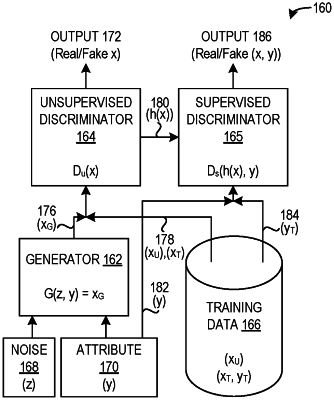| CPC G06V 10/82 (2022.01) [G06F 18/2413 (2023.01); G06N 3/08 (2013.01); G06V 10/451 (2022.01); G06V 10/764 (2022.01)] | 16 Claims |

|
1. A computer-implemented method for generating synthetic data objects using a semi-supervised generative adversarial network, the method comprising:
synthesizing, by a generator module, a data object xG derived from a noise vector z and an attribute label y,
wherein the semi-supervised generative adversarial network comprises the generator module, an unsupervised discriminator module, and a supervised discriminator module;
passing, to the unsupervised discriminator module, the data object xG and a set of training objects xT and xU which are obtained from a training data set,
wherein the training data set includes the xU objects which do not have a corresponding attribute label and further includes the xT objects that do have corresponding attribute labels yT;
calculating, by the unsupervised discriminator module, a value indicating a probability that the data object xG is real;
producing, by the unsupervised discriminator module, a first latent feature representation h(xG) of the data object xG and a second latent feature representation h(xT) of the data object xT;
passing the first and second latent feature representations h(xG) and h(xT) to the supervised discriminator module;
passing the attribute label y and an attribute label yT corresponding to the data object xT to the supervised discriminator module;
receiving, by the supervised discriminator module as input, a first pair comprising the first latent feature representation h(xG) produced by the unsupervised discriminator module and the attribute label y and a second pair comprising the second latent feature representation h(xT) produced by the unsupervised discriminator module and the corresponding yT attribute;
calculating, by the supervised discriminator module based on at least the first pair and the second pair, a value indicating a probability that the attribute label y given the data object xG is real; and
performing the aforementioned steps iteratively until the generator module produces data objects with a given attribute label which the unsupervised and supervised discriminator modules can no longer identify as fake.
|